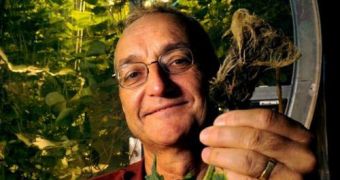Researchers with a new study have determined that it is possible, in theory, to use collapsible greenhouses to feed astronauts traveling to the Moon or Mars.
The team says that these constructs could be designed in such a manner that they respond to the specific conditions on the surface of the planets or moon were they are deployed to.
Fresh and healthy food could therefore be easily grown inside these structures, allowing a human group to survive without needing to carry vast amounts of food with them inside spacecrafts.
Experts with the Controlled Environment Agriculture Center (CEAC) at the University of Arizona say that they registering progress with their work on hydroponic growth, a process that requires no soil to grow various plants.
They say that this could enable future astronauts to grow their own peppers, potatoes, tomatoes, peanuts and so on without having to carry soil with them.
The investigators have already constructed a prototype of their new system, and installed it at the CEAC Extreme Climate Lab, Space reports.
For a future Martian base, the experts imagined a structure made of several tubular complexes, and their prototype simulates the last 8 feet (5.5 meters) of such a tube.
The CEAC team explains that the term greenhouse is used loosely in the context of their proposal. That is to say, their structures would not work as regular greenhouses do, by trapping sunlight in as heat.
First off, the tubular structures would be buried deep underground, which means that no sunlight will reach them directly.
Additionally, they will have to be shielded in such a way that plants growing within stay safe from micrometeorites, solar flares, radiation and other adverse factors in space.
UA experts say that the prototype can be collapsed down to a 4-foot disk, which means that it would easily fit in a spacecraft. Envelopes on the side would contain the seeds.
“We can deploy the module and have the water flowing to the lamps in just ten minutes. About 30 days later, you have vegetables,” says expert Phil Sadler in a statement.
He is the president of Sadler Machine Co., the company that designed and built the lunar greenhouse. All structures of this type would have water-cooled sodium vapor lamps.
“We want the system to operate itself. However, we're also trying to devise a remote decision-support system that would allow an operator on Earth to intervene,” adds UA associate professor of agricultural and biosystems engineering, Murat Kacira.
But the group believes that there are other applications in store for the new technology as well, perhaps even some closer to home.
“There's great interest in providing locally grown, fresh food in cities, for growing food right where masses of people are living,” explains Gene Giacomelli, the director of CEAC.
“It's the idea of growing high-quality fresh food that only has to be transported very short distances. There also would be a sense of agriculture returning to the everyday lives of urban dwellers. I think that idea is as exciting as establishing plant colonies on the moon,” he concludes.

 14 DAY TRIAL //
14 DAY TRIAL //